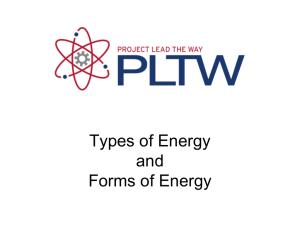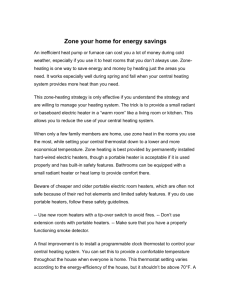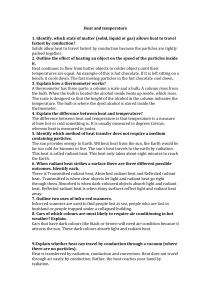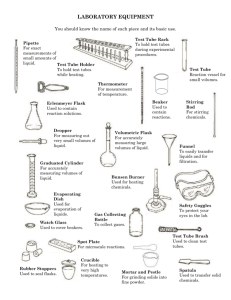NEWSLETTER - Alabama Cooperative Extension System
advertisement
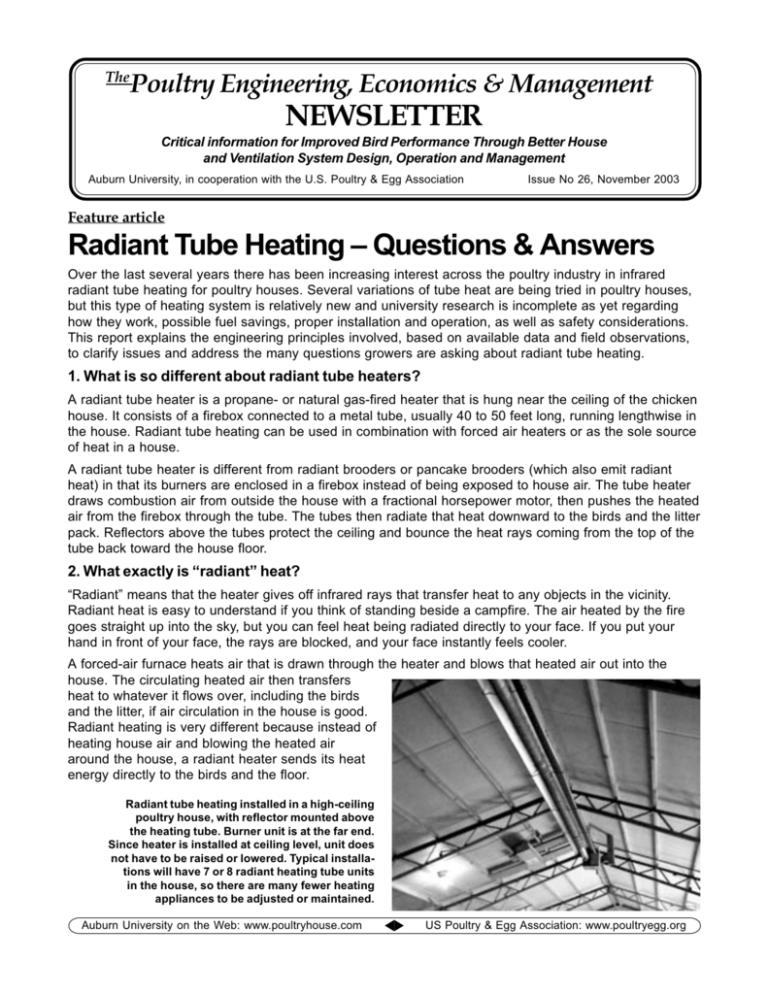
The Poultry Engineering, Economics & Management NEWSLETTER Critical information for Improved Bird Performance Through Better House and Ventilation System Design, Operation and Management Auburn University, in cooperation with the U.S. Poultry & Egg Association Issue No 26, November 2003 Feature article Radiant Tube Heating – Questions & Answers Over the last several years there has been increasing interest across the poultry industry in infrared radiant tube heating for poultry houses. Several variations of tube heat are being tried in poultry houses, but this type of heating system is relatively new and university research is incomplete as yet regarding how they work, possible fuel savings, proper installation and operation, as well as safety considerations. This report explains the engineering principles involved, based on available data and field observations, to clarify issues and address the many questions growers are asking about radiant tube heating. 1. What is so different about radiant tube heaters? A radiant tube heater is a propane- or natural gas-fired heater that is hung near the ceiling of the chicken house. It consists of a firebox connected to a metal tube, usually 40 to 50 feet long, running lengthwise in the house. Radiant tube heating can be used in combination with forced air heaters or as the sole source of heat in a house. A radiant tube heater is different from radiant brooders or pancake brooders (which also emit radiant heat) in that its burners are enclosed in a firebox instead of being exposed to house air. The tube heater draws combustion air from outside the house with a fractional horsepower motor, then pushes the heated air from the firebox through the tube. The tubes then radiate that heat downward to the birds and the litter pack. Reflectors above the tubes protect the ceiling and bounce the heat rays coming from the top of the tube back toward the house floor. 2. What exactly is “radiant” heat? “Radiant” means that the heater gives off infrared rays that transfer heat to any objects in the vicinity. Radiant heat is easy to understand if you think of standing beside a campfire. The air heated by the fire goes straight up into the sky, but you can feel heat being radiated directly to your face. If you put your hand in front of your face, the rays are blocked, and your face instantly feels cooler. A forced-air furnace heats air that is drawn through the heater and blows that heated air out into the house. The circulating heated air then transfers heat to whatever it flows over, including the birds and the litter, if air circulation in the house is good. Radiant heating is very different because instead of heating house air and blowing the heated air around the house, a radiant heater sends its heat energy directly to the birds and the floor. Radiant tube heating installed in a high-ceiling poultry house, with reflector mounted above the heating tube. Burner unit is at the far end. Since heater is installed at ceiling level, unit does not have to be raised or lowered. Typical installations will have 7 or 8 radiant heating tube units in the house, so there are many fewer heating appliances to be adjusted or maintained. Auburn University on the Web: www.poultryhouse.com US Poultry & Egg Association: www.poultryegg.org Radiant Tube Heat Forced-Air Furnace Heat WARM W A R M E ST WARMER WARMER W A R M E ST WARM Radiant tube heating transfers most of its warming energy directly to the litter pack (and the birds), so the floor area tends to be the warmest. Also, with heat energy being transferred directly to the birds, the air temperature at bird level will be some 2 to 5 degrees lower, for a given level of bird comfort, than in a furnace-heated house. This is an important management consideration: in periods when heating is called for, target air temperature for control purposes must be slightly lower than for forced-air heat. 3. What are the main advantages of radiant heating systems? If we can transfer warmth directly to the birds, without first having to heat the air and then circulate the air in order to heat the birds (and at the same time having heating all the rest of the house), then this type of heating should be more fuel efficient. Bird comfort is the purpose of heating, and if a system gets more heat energy directly to the birds it should be more efficient than any indirect system. Manufacturers of radiant tube heating for people typically recommend installing around 15% less total BTUs of heating capacity than would be used for forced-air furnaces. The American Society of Heating, Refrigerating and Air-Conditioning Engineers (ASHRAE) reports fuel savings much greater than that in some situations. We do not, however, currently have good studies showing exactly what fuel savings can be expected in poultry house heating. There are field reports that improved bird comfort with radiant heating systems has in turn resulted in improved feed conversion and growth rate, but as of yet there is insufficient evidence from the field or from research trials to be able to predict specific gains in bird performance with a high level of confidence. One benefit of radiant heating (both tube and radiant brooders) is that it does a better job of heating the litter. This is because the heat energy is being beamed directly to the floor of the house. Preheat times with radiant devices may be much less than with forced air systems, and measurements have shown that radiant heats the litter pack to a greater depth. So we get the effect of good warm toasty litter conditions and a warm bird at a lower ambient air temperature. This is important because if birds are standing on a cold litter pack, their body heat will be drained out of their body through their feet. The advantage of radiant tube heating over radiant brooders is that the heat source is mounted much higher in the house. This is very convenient, because the heaters are out of the way and do not have to be raised or lowered. The floor area being heated is much greater than for pancake or radiant brooders, Four 40-foot long radiant tube heaters installed in a 250-foot brood chamber (plan view, looking down at house floor). Warming pattern at floor level is egg-shaped, warmest directly under the heater tubing, less warm toward the walls. Combustion burners are located at end nearest end wall. Total floor area warmed by radiant tube heat is much larger than area warmed by typical radiant brooder installations. 2 FEED WATER T-STAT OR SENSOR Thermostats or sensors should be placed out of the main radiant heat zone. A common recommendation is to place sensors halfway between the outside water line and the feed line, and a foot or more above the floor. Exact placement may not be critical, but it is important to use the same arrangement consistently in all houses being managed. so a radiant tube system creates much less of a hot spot directly under the heater, and spreads warmth farther out toward the side walls. As with radiant brooders, there will still be temperature gradations, allowing birds to find the spot where they get exactly the warmth they need. But the birds will be much more spread out in a radiant tube heated house, and you generally do not see the doughnut ring that birds will form under a brooder. Also, radiant tube heating means fewer separate heating appliances to maintain and adjust, saving management time. Intake air for radiant tube heaters in chicken houses is normally drawn from outside the house. Using outside air keeps the burner unit and tubing much cleaner, so there is less maintenance required, and does not significantly affect fuel use. 4. Are management considerations for radiant tube heating different from brooders or box furnaces? Probably the first thing you would notice if you visit two poultry houses with same-age birds sitting side by side in winter time, one house with radiant tube heaters and the other with furnaces, and both houses are well managed for best bird comfort and performance, the air temperature in the radiant tube house will be lower, as is often the case in houses using radiant/pancake brooders. If the desired air temperature that will produce best bird comfort in the furnace-heated house is 92° F, in a radiant tube house we will often get the same best bird comfort conditions at an air temperature around 86-87° F at bird level. If we crank the air temperature up to 92° F in the tube house, the birds will be over-heated. The reason for this, as explained above, is that radiant tube heating transfers heat directly to the birds and the litter. The air in the house gets warmed up only by picking up heat from the litter and the birds. In other words, in radiant heated houses the air temperature does not need to be quite as high as that of a furnace-heated house. In the field we often find this to be 2 to 5 degrees lower in a house with radiant tube heaters, depending on circumstances and weather. This is an important management consideration. In a radiant tube heated house, you cannot set thermostats or temperature sensors according to a target temperature curve designed with forced-air heat in mind, as they typically are. Note that this applies only to periods when heating is required. The exact temperature setpoint offset to be used will vary, in large part depending on where the temperature sensor is placed and the height of the tube heater from the floor. If a temperature sensor is placed directly under the radiant tube, it will receive maximum radiant heat energy and will report an unrealistically high temperature. One common recommendation is to place thermostats or sensors about halfway between the outside water line and the feed line, lined up at the midpoint of the tube heater, and raised so as to be out of the main radiant heat zone. A good starting point would be a foot or so off the floor. Exact placement may not be critical, but the same placement arrangement should be used consistently in all houses being managed. It is preferable for each heater to have its own thermostat or controller sensor. For example, if there are four tube heaters in a brood chamber then there will be four heat zones in that brood chamber. Sensor placement and temperature control offsets should be checked and adjusted according to bird behavior. You want to see birds well spread out in the house and showing no signs of being too cold or too hot. 3 5. What are the characteristics that would make one brand or model of radiant tube heater better than another? We do not have independent standards or testing for this type of heater, but some will be more efficient than will others, depending on the engineering design and the type of materials used. That is, the superior model will put out a higher percentage of its heat energy input as radiant heat. As with most equipment, this means that the lowest-cost item may not be the best long-term choice. A higher initial cost may be over-balanced by more efficient operation for better fuel savings over the life of the system. For example, the material used for the heat-shield/reflector can affect the efficiency of the unit. A highly polished, mirror-like finish will reflect down toward the birds much more of the heat energy than will a dull, mill-finished metal, but will likely come with a higher price tag. (Note that this also can be a safety consideration, because much of the heat energy a reflector/shield absorbs will be re-radiated toward the ceiling.) Considerations of engineering and materials used in the combustion chamber and tubing are also important. Having the blower unit and all control components and wiring sealed in a well-insulated burner box is important for best performance and durability. A feature available from some manufacturers that may contribute to greater fuel savings is the ability to operate at high and low heat levels. A two-stage radiant tube burner might have a high heat output of 100,000 BTU and a low output of 65,000 BTU. The argument for this type design is that while high heat is available for times of severe cold, most of the time the heater stays on the lower setting, which means longer on-times and fewer on-off cycles. Any heating element will require warm-up time after ignition, during which it is burning fuel just to warm itself up, and this heat is not getting to the birds. Thus having fewer on-off cycles should cut down on the total amount of warm-up time and thus result in fuel savings. Also, extreme high and low temperature spikes are avoided, which will keep birds more comfortable, and equipment life may be increased. The dual or two-stage heating design has appeared to have merit in field tests and is sure to be one of the items University researchers will be focusing on in the near future. As for all newer technology, growers who are interested in a radiant tube system should not rely on manufacturer information alone, but should ask for advice from their integrator live production people and growers in their area who have experience with this type of heating system. The usual considerations of manufacturer reputation, quality of construction, and warranty terms offered should be observed. 6. How much heating capacity should I install in my house, if I am going to the radiant tube type system? The standard engineering calculations used to determine optimum heating capacity are based on the difference between the predicted outside low temperature and the desired inside temperature, given a certain rate of heat loss depending on amount of insulation in the building and how well sealed the building is. Since with radiant heating systems we operate at a slightly lower target air temperature, these calculations will show that radiant heating systems can be sized at slightly less heating capacity than forced-air heating systems. However, it is important to realize that many modern poultry houses using forced-air heat have oversized systems installed. This happens because the same rule-of-thumb sizing Workman installing element designed to even out temperature from combustion chamber to end of tubing. The device, installed in the last 10-15 feet of tubing, acts as a heat sink to extract heat from the exhaust gases and convert it into radiant energy. Radiant tube manufacturers use various devices of this kind to help improve the radiating efficiency of the heater. Note bracket on tubing that will be used for installing the reflector/heat shield to protect house ceiling and direct radiant energy toward the birds and the litter. 4 Typical installation plan for a 43 x 500 foot broiler house. As the illustration shows, many fewer radiant tube heating units are usually required, compared with either radiant brooder or forced-air furnace heat. This means less times needs to be spent in adjusting or maintaining heating appliances. Normally, one thermostat or temperature sensor is used for each tube heater. requirements determined decades ago for under-insulated and leaky, curtain-sided houses are being used for mostly solid-wall and tight, well-insulated newer houses. For example, following are results of standard engineering calculations of heating capacity needed for the brood half of typical examples of three house types under typical Southeastern conditions where we assume a design outside temperature of 10° F and a design inside temperature of 92° F for the forcedair heated houses and 88° F for the radiant heated house: – 630,250 BTU/hr heating capacity needed for the older house (forced-air heat, 92° F desired temp) – 301,675 BTU/hr heating capacity needed for a modern house (forced-air heat, 92° F desired temp) – 285,613 BTU/hr heating capacity needed for a modern house (radiant tube heat, 88° F desired temp) The exact heating capacity needed for your particular situation may be very different, whether you use one or the other heating system type. Also, preferences vary on whether to build in a larger or smaller, or even no safety factor. A point to keep in mind is that an over-sized system will not only be more costly to buy, it may be more expensive to operate because it will be running on shorter on-off cycles. 7. What about maintenance considerations with radiant tube heating? Since radiant tube heaters for poultry houses draw combustion air from outside, they stay much cleaner and require much less maintenance than forced-air furnaces do (assuming that the radiant tube heater draws intake air from outside the house and has its blower in a sealed burner box). They do have a moving part, the combustion air blower, which will require periodic attention. Reflectors and radiant tubes must be cleaned periodically to maintain maximum heating efficiency. Overall, the radiant tube heater may require less maintenance attention than either forced-air furnaces or radiant brooders. 8. Are there any special safety considerations in using radiant tube heaters? Yes, there are safety considerations to be observed. Having an intense heat source near the ceiling can create a fire hazard if the manufacturer’s installation instructions are not followed carefully. Manufacturers’ specifications for clearance distances must be strictly observed. Reflectors must be correctly installed to shield the ceiling material from heat, and must be kept clean. If a reflector gets dirty it will heat up, creating a risk of heating the ceiling vapor barrier to the melting point. The ceiling itself must be in good condition and checked frequently. You do not want to have bands breaking and tri-ply or insulation falling onto a heater. Additional shielding of the ceiling may be desirable. 5 In high ceiling poultry houses the heater usually is not as close to combustible materials as in a droppedceiling house and it certainly appears that radiant tube heaters have found a place in high ceiling poultry houses. A concern in this type of house, however, is interference with tunnel ventilation baffle curtains. In most cases the baffle curtains have holes cut in them and the radiant heater tube goes through the holes. If this is done, the holes must be big enough and care taken to make sure the plastic baffle curtain is kept far enough away from the radiant tube so it does not melt or catch fire. The minimum top clearance manufacturers require varies; for most poultry houses, at least one foot clearance should be maintained between the top of the heat shield/reflector and the baffle (or ceiling). Bottom clearances (where there is no reflector) are usually much greater. An alternative solution is to shield the underside of the radiant tube where it passes through the baffle curtain with a small piece of reflector attached to the tubing. A concern in dropped ceiling houses is that the tube heaters can and have melted fogger lines in the ceiling above them. Again, manufacturer clearance specifications must be observed. Items such as electrical wiring and fogger lines may need extra protection from high heat. The Bottom Line Radiant tube heating is too new in the poultry industry to have either an extensive track record in the field or for there to be complete University research findings. However, several manufacturers have models designed for poultry house use, and these are being installed, especially in new-construction dropped-ceiling houses, and in highceiling houses, both new and as retrofit. From an engineering standpoint, this type of heating has proven value in industrial spaceheating applications and offers practical advantages especially suited to broiler house applications, such as requiring less management attention or maintenance, and not having to be raised or removed to make room for flock harvest operations, litter renovation, or other needs. What remains to be seen is whether the poultry industry can adapt this new technology to optimize bird performance and comfort over other heating options at an economic advantage. As we receive information and data from the many field tests under way we will keep you informed. Jim Donald, Extension Engineer, Auburn University Mike Czarick, Extension Engineer, University of Georgia The Poultry Engineering, Economics and Management Newsletter is now being produced in cooperation with the U.S. Poultry & Egg Association, as part of their commitment to poultry industry education. We are proud of this new association, and know it will help to improve our continuing efforts to bring you the critical information you need to know about poultry engineering, economics and management. Thanks to the following for their support of Extension poultry engineering programs at Auburn University: Diamond Aerotech/Munters ............... 888-335-0100 Agrifan ................................. 800-236-7080 CANARM Ltd. ...................... 800-267-4427 EXPERT CONTROLS .......... 877-926-2777 Hired Hand, Inc. .................. 800-642-0123 Poultry Guard ....................... 312-706-3294 Poultry Litter Treatment-PLT .. 800-379-2243 VALCO ................................. 888-345-8956 Platinum Diversified Imports/ROTEM .. 800-348-6663 Pro-Tech, Inc. ........... www.pro-techinc.com Gold ACME Engineering ............. 800-382-2263 Big Dutchman ..................... 616-392-5981 Chore-Time .......................... 219-658-4101 Reeves Supply .................... 888-854-5221 Silver Aviagen ................................ 800-826-9685 BioSentry .............................. 800-788-4246 CoolAir .................................. 904-389-1469 Cumberland ......................... 217-226-4401 Dandy .................................. 800-222-4166 Detroit Radiant Products Co. ......... www.reverberray.com Dyer Poultry Supply ............ 256-796-2310 Ellison and Ellison .............. 770-427-8929 Federal Land Bank Assoc. of North Alabama ............ 888-305-0074 First South Farm Credit ........ 800-955-1722 Lewis Brothers ...................... 912-367-4651 Monitor Co. ........................... 800-537-3201 Motomco .............................. 800-237-6843 Multifan/Vostermans Ventilation, Inc. ................ 800-458-5532 Porter Insulation Products ... 800-999-0430 Space Ray ............................ 704-372-3485 WYNCO ................................ 800-643-3064 The Poultry Engineering, Economics and Management newsletter provides up-to-date information on topics of interest to poultry production personnel, focusing on most effective and efficient uses of modern technology and equipment, with a special emphasis on economic implications. The Newsletter is published six times a year, or as needed to address emerging or special issues. Contact: Jim Donald, Extension Biosystems Engineering, 228 Corley Bldg., Auburn University, AL 36849-5626, (334) 844-4181, fax (334)-844-3548, jimdonald@aces.edu. Published by: Jim Donald, Extension Engineer Auburn University Mike Eckman, Extension Poultry Scientist Auburn University Gene Simpson, Extension Economist Auburn University Issued in furtherance of Cooperative Extension work in agriculture and home economics, Acts of May 8 and June 30, 1914, and other related acts, in cooperation with the U.S. Department of Agriculture. The Alabama Cooperative Extension System ( Alabama A&M University and Auburn University) offers educational programs, materials, and equal opportunity employment to all people without regard to race, color, national origin, religion, sex, age, veteran status, or disability. Auburn University on the Web: www.poultryhouse.com US Poultry & Egg Association: www.poultryegg.org
